| Construction Rating: | starstarstarstarstar_border |
| Flight Rating: | starstarstarstarstar_border |
| Overall Rating: | starstarstarstarstar_border |
| Manufacturer: | BSD High Power Rocketry  |
 Overview
Overview
I had never built a high power kit, but after many hours searching the Internet, I felt confident in placing an order for a BSD Horizon. The company’s website was pretty adamant about the Horizon being the best way to certify Level 1. They cited simple design, strong construction and excellent instructions. I knew that since I had no high power experience I would need all of the above.
After a phone call to Scott Binder, in Washington State, the box with my Horizon arrived three days later via Priority Mail. Unpacking the kit found all the items neatly packaged, present and accounted for.
The Kit
The kit includes: (3) cut and match sanded 3/16" aircraft grade plywood fins, Kraft glassine (LOC style) 24" booster and 10" payload airframes, coupler, laser-cut medium density fiberboard (2) centering rings and (1) bulkhead plate, 4" plastic nose cone, 38mm x 10" motor tube, motor retention system, 30" orange nylon parachute, (2) eyebolt/washer/nut assemblies, ½" launch lug, a quick link, a 1" x 20’ elastic shock cord and a nylon shock cord strap with grommets.
Also included were a fin alignment guide printed on heavy cardstock, a 9-page instruction booklet and a cut vinyl lettering graphics package.
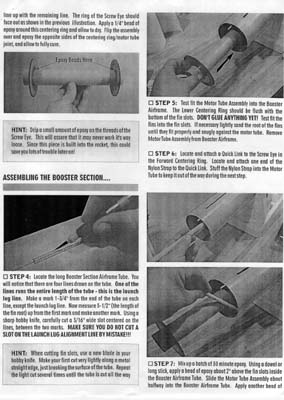 Assembling the Motor Tube
Assembling the Motor Tube
The booster tube was not pre-slotted, but was marked for fin and launch lug placements. Trial fitting the laser cut centering rings and bulkhead plate left me encouraged that the kit would go together easily.
I used NHP 30 minute epoxy for almost all of the work on the Horizon. When they say to "mix thoroughly" they mean it!
The motor tube assembly consisted of using epoxy to secure the fore and aft centering rings. The centering rings have a smooth side and a rough side and I chose to put the rough sides facing in towards each other. A ¼" hole needs to be drilled through the front centering ring for one of the eyebolt assemblies. Hint boxes are sprinkled throughout the instructions. HINT: Drip a small amount of epoxy on the threads of the screw eye.
Assembling the Booster Section
The first step is to cut the fin slots. While not difficult, it would’ve been nice to have the tubes pre-slotted. Next, test fit the motor tube assembly into the booster until the aft centering ring is flush with the bottoms of the fin slots. The aft centering ring required light sanding. Test fit the fins through the airframe slots and onto the motor tube. I marked the fins 1,2,3 and made a mark on both the booster and the aft centering ring as one orientation of all parts seemed to have the best fit.
Next I attached the grommet on the shock cord strap with the quick link to the eyebolt. Then I stuffed the shock cord into the motor tube to keep it out of the way and permanently affixed the motor tube assembly into the booster.
Note: When I ordered the Horizon, Scott was pretty excited about something called milled fiber. Milled fiber is 1/32" pieces of milled fiberglass that appears as a white powder. When mixed one-third each of resin, hardener and milled fiber, Scott claims the fiber will make the epoxy 3 times stronger than normal.
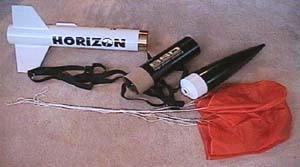 Once the airframe assembly was completely cured, I turned it upside-down and applied 10 minute epoxy to protect the bottom of the rocket from heat and impact.
Once the airframe assembly was completely cured, I turned it upside-down and applied 10 minute epoxy to protect the bottom of the rocket from heat and impact.
The fins were then shaped, attached and reinforced with epoxy and milled fiber fillets, as was the single ½" launch lug.
Assembling the Payload Section
The bulkhead already had a ¼" hole pre-drilled in its center for the aft-facing eyebolt assembly. This bulkhead is affixed to the 3.9" coupler and the bulkhead/coupler assembly is then attached to the payload airframe with epoxy.
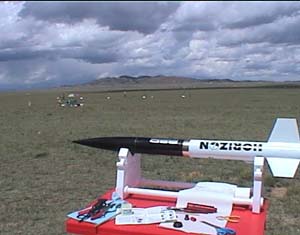 Final Assembly
Final Assembly
The 4" plastic nose cone was washed, sanded and prepped for painting. Pretty detailed instructions are included for painting the rocket. I used a Rustoleum rattle can gray automotive primer for my base and mid coats, then used a white primer for my top primer coat. Color finish was Krylon Hi-Gloss black for the payload section and the nose cone, with Krylon Hi-Gloss white being used for the booster section.
One of the unusual things about the BSD kit is that what you see is what you get. A graphics package of cut vinyl lettering made of 7-8 year exterior life commercial grade vinyl was included in the Horizon kit. When the application tape is peeled off its backing the letters and graphics stick to the application tape. You then have one chance to stick the tape to the rocket in the right spot. It’s actually pretty easy and once the tape is stuck you just smooth it out, peel the tape back up and you’ve got the letters and graphics stuck to the rocket. Nice!
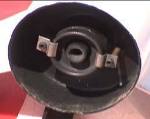 For construction I would rate this kit 4½ points.
For construction I would rate this kit 4½ points.
Pre-flight
A full page of the instruction booklet is dedicated to the parachute, motor prep, wadding (I used blow fill insulation), pre-flight fitting of the sections, etc.
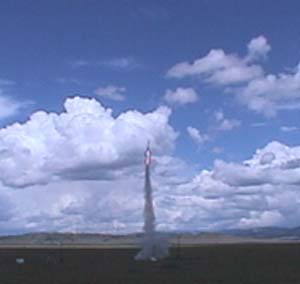 Level 1 Flight
Level 1 Flight
Consistent with my goal of becoming Level 1 certified, I joined Tripoli Colorado, arranged to buy an H123W-Medium delay motor, and attended the club launch at Hartsel, CO.
"Skies are clear, time is running…T minus 5,4,3,2,1 ignition," and then for a few unbearable seconds nothing, absolutely nothing, then the motor barked to life and the Horizon roared straight off the pad and sailed 1400 feet up into the deep blue Colorado sky. The 30" orange parachute deployed right on cue, the pieces held together and I finally heard the words I had been waiting all month to hear, "Welcome to High Power."
For flight/recovery I would rate this kit 4½ points.
Special thanks to Scott Binder, Cam Meek and Ken Mizoi for all their support.
Other Reviews
- BSD High Power Rocketry Horizon By Gene Wolski (October 21, 2011)
BSD Horizon (4") with 38mm motor mount. I flew this rocket stock for my Level 1, and I later modified it to use dual deployment for my Level 2. Components BSD Rocketry Horizon (4" diameter) with 38mm motor mount and G-10 fins Components: Nose cone Payload section (10") Tube coupler, bulkhead plate, and hardware Booster section (24") 38mm motor tube ...
- BSD High Power Rocketry Horizon By Gary Sinclair
Fully glassed airframe and fins. External fin-can assembly with Kevlar tape reinforcement of fin to motor mount. Carbon fibre reinforced payload bay coupler. Replace shock cord with tubular nylon. Modifications: I wanted another short 4" rocket to go with my 4" Yank Bullet and the BSD Horizon seemed to fit and offered a lot of kit for a very reasonable price. As usual with my kits I like to ...
 |
 |
Flights
 |
 |
BJ (March 4, 2002)
C.P. (April 1, 2002)
J.K. (December 26, 2002)
A.M. (April 16, 2003)
K.T. (April 22, 2004)
K.T. (June 2, 2004)
Sponsored Ads
 |
 |












G.S. (April 1, 2001)